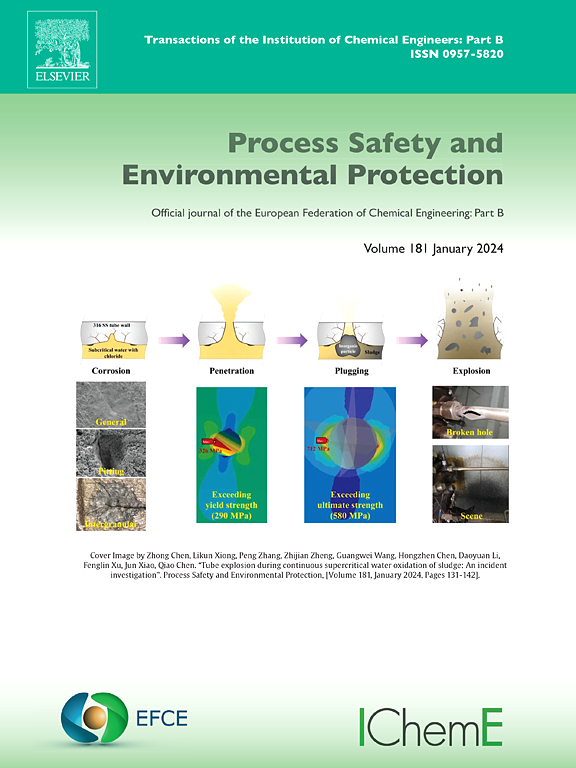Enhancing the anti-corrosion performance of steel alloy via surface functionalization with green benzylhydrazineyl imidazolone-based inhibitors: Electrochemical behavior and adsorption mechanism
IF 7.8
2区 环境科学与生态学
Q1 ENGINEERING, CHEMICAL
引用次数: 0
Abstract
The pressing need for high-performance, environmentally-friendly corrosion inhibitors has led to the exploration of new organic compounds for the protection of mild steel in aggressive environments. In this study, two recently synthesized benzylhydrazineyl imidazolone derivatives, ClPh-DDI and FPh-DDI, are presented as highly effective corrosion inhibitors for mild steel in 1 M HCl. The electrochemical impedance spectroscopy and potentiodynamic polarization analyses confirmed remarkable inhibition efficiencies of 99.0 % and 99.2 % at 10−4 M for ClPh-DDI and FPh-DDI, respectively. The adsorption behavior followed the Langmuir isotherm, with ΔG°ads values of −50.4 and −54.6 kJ/mol indicating chemisorption. The density functional theory calculations revealed strong electronic interactions with the Fe(110) surface, while Monte Carlo simulations confirmed optimal molecular orientation and surface coverage. Analyses by scanning electron microscopy and energy-dispersive X-ray also validated the formation of a compact protective film. These findings underline the potential of ClPh-DDI and FPh-DDI as highly effective, long-lasting inhibitors for industrial corrosion protection.
绿色苄基肼基咪唑酮类缓蚀剂表面功能化提高钢合金的防腐性能:电化学行为及吸附机理
对高性能、环保型缓蚀剂的迫切需求导致了新的有机化合物的探索,以保护低碳钢在腐蚀性环境中。在这项研究中,最近合成的两种苯肼基咪唑酮衍生物ClPh-DDI和FPh-DDI在1 M HCl中作为低碳钢的高效缓蚀剂。电化学阻抗谱和动电位极化分析证实,在10−4 M条件下,ClPh-DDI和FPh-DDI的缓蚀效率分别为99.0 %和99.2 %。吸附行为遵循Langmuir等温线,ΔG°ads值分别为−50.4和−54.6 kJ/mol,表明发生了化学吸附。密度泛函理论计算揭示了与Fe(110)表面的强电子相互作用,而蒙特卡罗模拟证实了最佳的分子取向和表面覆盖率。扫描电子显微镜和能量色散x射线分析也证实了致密保护膜的形成。这些发现强调了ClPh-DDI和FPh-DDI作为高效、持久的工业防腐抑制剂的潜力。
本文章由计算机程序翻译,如有差异,请以英文原文为准。
求助全文
约1分钟内获得全文
求助全文
来源期刊

Process Safety and Environmental Protection
环境科学-工程:化工
CiteScore
11.40
自引率
15.40%
发文量
929
审稿时长
8.0 months
期刊介绍:
The Process Safety and Environmental Protection (PSEP) journal is a leading international publication that focuses on the publication of high-quality, original research papers in the field of engineering, specifically those related to the safety of industrial processes and environmental protection. The journal encourages submissions that present new developments in safety and environmental aspects, particularly those that show how research findings can be applied in process engineering design and practice.
PSEP is particularly interested in research that brings fresh perspectives to established engineering principles, identifies unsolved problems, or suggests directions for future research. The journal also values contributions that push the boundaries of traditional engineering and welcomes multidisciplinary papers.
PSEP's articles are abstracted and indexed by a range of databases and services, which helps to ensure that the journal's research is accessible and recognized in the academic and professional communities. These databases include ANTE, Chemical Abstracts, Chemical Hazards in Industry, Current Contents, Elsevier Engineering Information database, Pascal Francis, Web of Science, Scopus, Engineering Information Database EnCompass LIT (Elsevier), and INSPEC. This wide coverage facilitates the dissemination of the journal's content to a global audience interested in process safety and environmental engineering.
 求助内容:
求助内容: 应助结果提醒方式:
应助结果提醒方式:


